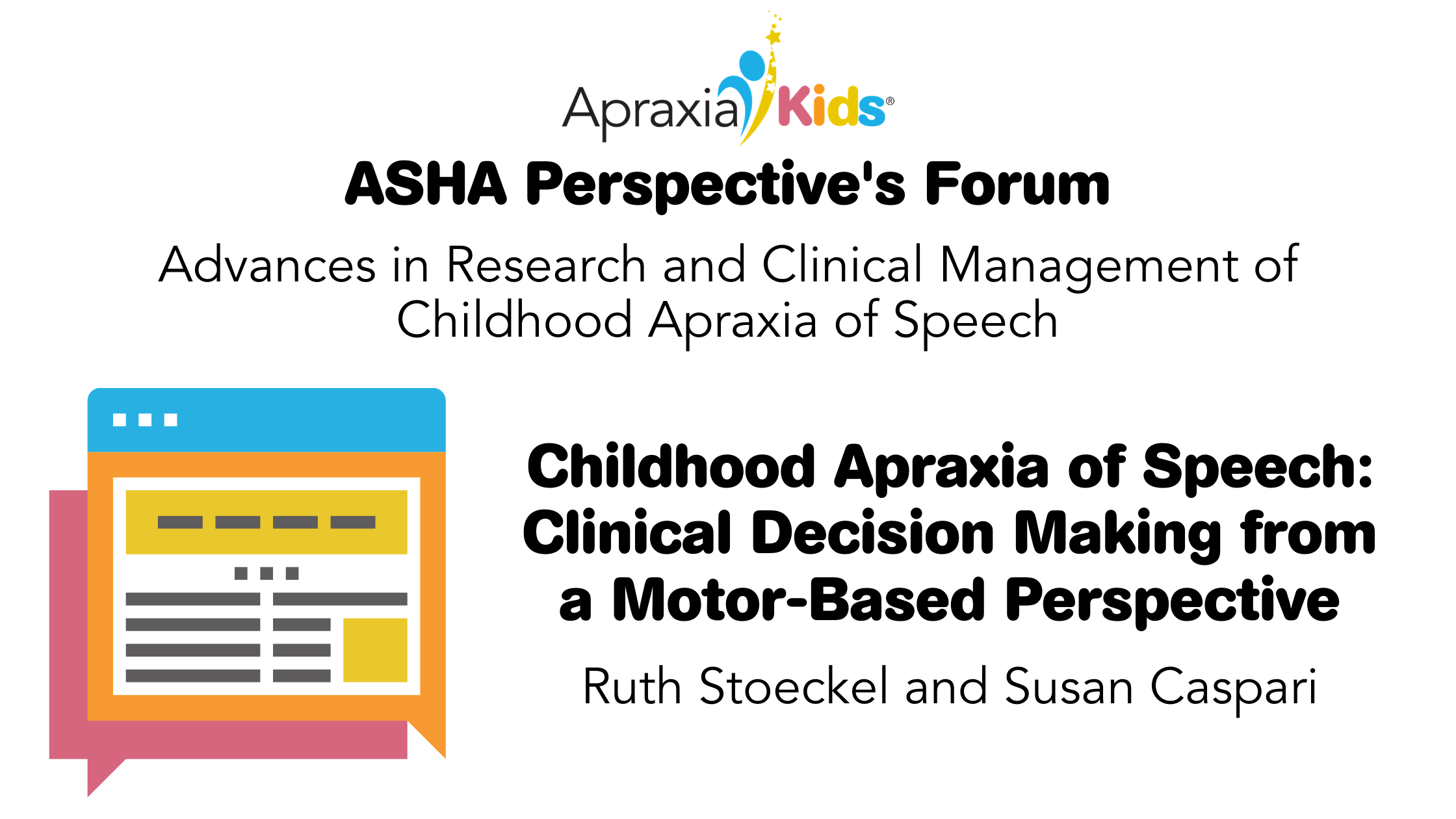
22 Jul Childhood Apraxia of Speech: Clinical Decision Making from a Motor-Based Perspective
Ruth Stoeckel and Susan Caspari published an article titled Childhood apraxia of speech: clinical decision making from a motor-based perspective in an ASHA Perspectives Clinical Forum dedicated to Childhood Apraxia of Speech. The article demonstrates how the process of evidence based practice can be applied to clinical decision making through two case examples and is summarized here.
Childhood Apraxia of Speech: Clinical Decision Making from a Motor-Based Perspective
Article and Summary by Ruth Stoeckel and Susan Caspari
Social media is filled with mentions of various treatment approaches for children with childhood apraxia of speech (CAS). As a parent or clinician, we might wonder, which approach is best? Which one should be used for a particular child? In this Viewpoint article, the clinical decision making for two cases is reviewed demonstrating how evidence from the literature can be used to customize assessment and treatment for individual children with CAS, and showing how progress can be monitored with data to drive ongoing treatment decisions.
In the case of Ella, a 2 year 8 month old child who was resistant to attempts at verbal imitation, details are provided to demonstrate how informal observation combined with a period of diagnostic therapy and family involvement enabled the team to make diagnostic hypotheses and identify specific goals to help Ella increase both her willingness to cooperate in therapy and begin to make improvements in speech intelligibility. In the case of Maddie, a 15 year old with a history of CAS and ongoing intelligibility issues, individual client factors informed the decisions to combine elements of two different approaches into a hybrid treatment approach. Functional words and phrases were selected and a specific treatment hierarchy was used based on one approach. Elements of the second approach that involved a self-monitoring procedure were utilized to help her internalize the learning.
It is suggested that there is no single approach to intervention that will be appropriate for every child with CAS or even for a given child with CAS throughout the course of their treatment. Customizing treatment for children with CAS with evidence based practice in mind will involve 1) considering best available evidence; 2) considering child/family preferences; and 3) clinical judgment that includes using data from the child’s response to treatment to track progress and adjust goals as needed throughout the course of treatment.
ASHA Sig 2 Perspectives Forum May, 2020
https://doi.org/10.1044/2020_PERSP-19-00090
Ruth Stoeckel and Susan Caspari published an article titled Childhood apraxia of speech: clinical decision making from a motor-based perspective in an ASHA Perspectives Clinical Forum dedicated to Childhood Apraxia of Speech. The article demonstrates how the process of evidence based practice can be applied to clinical decision making through two case examples and is summarized here.
Childhood Apraxia of Speech: Clinical Decision Making from a Motor-Based Perspective
Article and Summary by Ruth Stoeckel and Susan Caspari
Social media is filled with mentions of various treatment approaches for children with childhood apraxia of speech (CAS). As a parent or clinician, we might wonder, which approach is best? Which one should be used for a particular child? In this Viewpoint article, the clinical decision making for two cases is reviewed demonstrating how evidence from the literature can be used to customize assessment and treatment for individual children with CAS, and showing how progress can be monitored with data to drive ongoing treatment decisions.
In the case of Ella, a 2 year 8 month old child who was resistant to attempts at verbal imitation, details are provided to demonstrate how informal observation combined with a period of diagnostic therapy and family involvement enabled the team to make diagnostic hypotheses and identify specific goals to help Ella increase both her willingness to cooperate in therapy and begin to make improvements in speech intelligibility. In the case of Maddie, a 15 year old with a history of CAS and ongoing intelligibility issues, individual client factors informed the decisions to combine elements of two different approaches into a hybrid treatment approach. Functional words and phrases were selected and a specific treatment hierarchy was used based on one approach. Elements of the second approach that involved a self-monitoring procedure were utilized to help her internalize the learning.
It is suggested that there is no single approach to intervention that will be appropriate for every child with CAS or even for a given child with CAS throughout the course of their treatment. Customizing treatment for children with CAS with evidence based practice in mind will involve 1) considering best available evidence; 2) considering child/family preferences; and 3) clinical judgment that includes using data from the child’s response to treatment to track progress and adjust goals as needed throughout the course of treatment.
ASHA Sig 2 Perspectives Forum May, 2020
https://doi.org/10.1044/2020_PERSP-19-00090
Credentials:
Hours of Operation:
Treatment locations:
Address:
,
Phone:
Email:
Overall Treatment Approach:
Percent of CAS cases:
Parent Involvement:
Community Involvement:
Professional consultation/collaboration:
Min Age Treated:
Max Age Treated:
Insurance Accepted:




